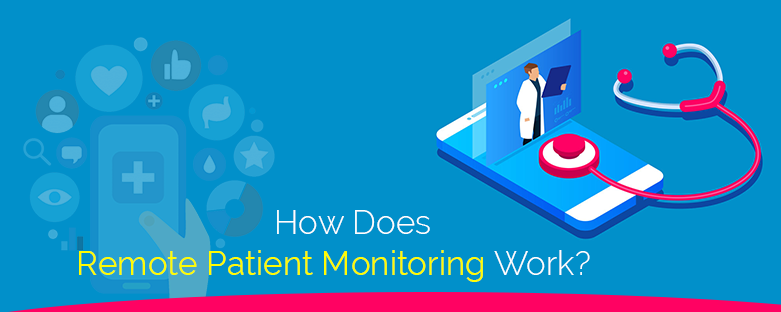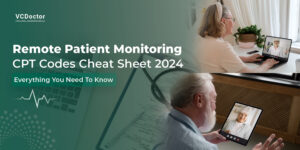How does Remote Patient Monitoring work?
Remote patient monitoring is a collection of technology and procedures that allow healthcare providers to track improvements in the health data of a patient from a distance in real-time and use it in a treatment plan. RPMS’s an important part of the larger e-health and telehealth sector. Below we are discussing How does Remote Patient Monitoring work?
Remote patient monitoring utilizes emerging technology in one place to gather medical and other types of health data from users and this information is safely distributed remotely to health care providers in various areas for review and recommendation.
When patients and health care providers want health to be tracked outside of the healthcare setting, Remote patient monitoring is becoming more common.
Remote monitoring focuses on medically ill patients, post-operative patients and remote patients with restricted access to healthcare services.
How Remote Patient Monitoring Works?
The system of remote patient monitoring is a method of healthcare delivery that applies technologies beyond a conventional hospital environment to observe patient health.
Although remote patient monitoring does not totally eliminate in-person treatment, the pressure imposed on both providers and patients can certainly be eased. Via a particular set of functions, remote patient monitoring achieves this efficient communication.
These steps make you know that How Does Remote Patient Monitoring Work.
1. Collection:-
After the patient monitor is enabled by the customer, information is gathered, placed on internal systems, and formatted for delivery to the healthcare doctor of the patient.
2. Transmission-
The captured data is then transferred over the internet, telephone, email, or other means of contact to the healthcare facility.
3. Assessment –
Internal algorithmic software and healthcare experts may review details and indicate any areas of interest. Information is then sent back to the patient or the healthcare staff of the patient about these questions.
4. Notification-
Warnings will be provided to designate first responders in case the doctor detects a discontinuity in the data that demands urgent treatment.
5. Action-
An emergency response team will provide the patient with immediate help and will even describe what happens and approaches in the future to stop any similar occurrence.
Benefits of Remote Patient Monitoring
1. Improved Quality
Remote monitoring also has the potential to increase the standard of treatment, in addition to improving the volume of care. Since remote patient monitoring links physicians with appropriate medical data more directly (and almost instantly), it makes their everyday routines more productive and eases the risk of burnout, resulting in visible benefits for online patient care.
Much further, by developing a framework in which individuals are more involved with and responsible for their well-being, remote monitoring promotes patient behaviour. Efficient remote patient monitoring programs deliver equipment that is genuinely relaxed and common for patients, far from being the icy, sterile, daunting medical technology that comes to mind for many customers.
2. Remote Patient Monitoring Eliminates Unnecessary Visits
Remote monitoring moves in by tracking patients around the clock and submitting reports in real-time to health care providers when it comes to reducing healthcare costs. The demand for in-person visits is changing as a consequence.
In-home healthcare treatment services capture critical health statistics using remote monitoring, such as readings of blood pressure, pulse rate, respiration, glucose levels, weight, and more. It reduces the need for daily, in-person appointments that are all about obtaining health information.
3. Improve care experience with Remote Patient Monitoring
Remote patient monitoring increases the experience of treatment by supplying people with everyday contact, thereby enhancing the quality of life and keeping patients at home. Remote monitoring affects the second objective of healthcare, patient retention, allowing them the ability to connect on a daily basis. As patients are detected, it really leads to improved outcomes and pushes them onto a self-management basis, improving their condition.
Read Also: Why Telemedicine is good for Senior Care
4. Makes Accessible and Affordable Healthcare
Remote monitoring alerts patients and clinicians about wellbeing parameter fluctuations, which helps them to handle the problem before things get out of control. Advanced characteristics that monitor pulse rhythm, ECG, respiratory rates, blood pressure, blood oxygen volume, etc. will help avoid accidents such as extreme hypoglycemia, blood clots, and heart blocks. It also makes it easier for people to keep track of their well-being without daily checkups, saving time and money because they do not have to be physically present in hospitals.
5. Improved Patient Outcomes
Remote monitoring possibilities include catching out-of-range beliefs that may be dangerous, identifying patterns that could suggest a need to adjust the treatment regime, and getting coaching on everyday decisions that may sometimes be put aside considering their substantial effect on chronic illnesses, such as physical exercise. In conjunction with health-promoting help, such as coaching on sleep or stress control, such benefits may improve.
6. Reduced readmissions Remote Patient Monitoring
Remote monitoring helps enhance patient interaction and attitudes by leveraging consumer-centric devices (smartphones, laptops, software, etc.), and making patients more responsible for their own care. Unlike the largely impersonal medical technologies they are usually introduced to in healthcare environments, successful corporate success improvement systems strive to use technology that is intuitive and convenient for patients.
For improved disease-management assistance, Remote monitoring provides patients with higher levels of reviews, connectivity, and knowledge. That leads to better health outcomes, lower readmission rates, and increased health of the population.
7. Early symptom detection
Healthcare facilities consistently receive real-time patient health data with a remote patient monitoring solution. The solution measures clinical parameters and offers important information on the course of the illness or injury. This data will help you change the treatment plan, prevent potential epiphenomena, and avoid chronic care management emergencies.





Remote Patient Monitoring is an essential thing that healthcare should adapt quickly. It can help doctors to provide better treatment and cures to patients.